Higher Education Acceptance Letter
[Your Name]
[Your Address]
[City, State, Zip Code]
[Email Address]
[Phone Number]
[Date]
[Admissions Office]
[Name of the University/College]
[Address of the University/College]
[City, State, Zip Code]
Dear [Admissions Committee],
I hope this letter finds you well. I am writing to express my heartfelt gratitude and excitement upon receiving my acceptance into [Name of the University/College] for the [Name of the Program] program.
I am extremely honored and thrilled to have been offered the opportunity to be a part of such a prestigious institution known for its commitment to excellence in [your field of study/academic pursuits]. The reputation of [Name of the University/College] as a leading center of academic and intellectual growth has always inspired me, and I am eager to contribute to the rich academic community.
Throughout my academic journey, I have strived to maintain a strong academic record, and I am elated that my hard work and dedication have been recognized by your esteemed institution. I am certain that the world-class faculty, cutting-edge research opportunities, and vibrant campus life at [Name of the University/College] will provide me with the ideal environment to enhance my knowledge and skills.
The chance to immerse myself in a diverse and intellectually stimulating environment is one that I wholeheartedly welcome. I am confident that [Name of the University/College] will help me develop not only academically but also as an individual, fostering personal growth, leadership qualities, and a sense of social responsibility.
As I plan my transition to [Name of the University/College], I understand the importance of the responsibilities and expectations that come with being a student at your esteemed institution. I pledge to make the most of this opportunity and contribute positively to the university community.
Once again, I would like to express my sincerest gratitude for granting me admission to [Name of the University/College]. Please find enclosed all the necessary documents required for enrollment. I assure you that I will complete all the formalities as soon as possible.
If there is any additional information required or further documentation needed, please do not hesitate to contact me. I look forward to joining [Name of the University/College] and making a meaningful impact on its academic and social fabric.
Thank you once again for this extraordinary opportunity. I am eager to begin my journey as a [Name of the University/College] student and contribute to the institution's legacy.
Yours sincerely,
[Your Name]
Standard University Acceptance Letter
Dear [Student Name],
Congratulations! It is with great pleasure that the Office of Admissions at [University Name] offers you admission to our [Program Name] for the [Fall/Spring] semester of [Year].
After careful review of your application, academic records, and supporting materials, our admissions committee was impressed by your achievements and potential. Your academic excellence, demonstrated leadership, and commitment to personal growth make you an ideal candidate for our community.
You have been accepted into the [College/School Name] with a proposed major in [Field of Study]. Your admission is effective beginning [Start Date], and you will be joining a class of exceptional students from around the world.
To confirm your enrollment, please submit your intent to enroll form and the required enrollment deposit of $[Amount] by [Deadline Date]. You will also need to complete the following steps: submit your final transcripts, complete housing applications, and attend our new student orientation on [Date].
We have also enclosed information about financial aid opportunities, scholarship awards (if applicable), and housing options. Our student services team is available to assist you with any questions during this transition.
We are excited to welcome you to [University Name] and look forward to seeing you contribute to our vibrant academic community.
Warmest congratulations on this achievement!
Sincerely,
[Name]
Director of Admissions
[University Name]
Early Decision Acceptance Letter
Dear [Student Name],
It is my distinct pleasure to inform you that you have been accepted to [University Name] through our Early Decision program for the Class of [Year].
Your application stood out among an exceptionally competitive pool of early applicants. The admissions committee was particularly impressed by your academic rigor, intellectual curiosity, and the depth of your extracurricular involvement. Your essay revealed a thoughtful and mature perspective that aligns perfectly with our institutional values.
As an Early Decision admit, you are required to withdraw all applications to other institutions and commit to enrolling at [University Name]. This binding agreement must be confirmed by submitting your enrollment deposit of $[Amount] by [Date], which is earlier than our regular decision deadline.
Your acceptance includes admission to [College/School Name] with your intended major in [Field of Study]. You will receive a separate communication regarding financial aid and scholarship opportunities within the next two weeks.
Please complete the following by [Date]: submit your final high school transcripts, complete the enrollment confirmation form, and withdraw all other college applications. Our early decision coordinator will be in touch to guide you through the next steps.
We are thrilled that you will be joining our community and cannot wait to see the contributions you will make to campus life.
Congratulations on this significant accomplishment!
Sincerely,
[Name]
Dean of Admissions
[University Name]
Conditional Acceptance Letter
Dear [Student Name],
The Admissions Committee at [University Name] is pleased to offer you conditional admission to our [Program Name] for the [Semester] semester of [Year].
Your application demonstrates strong potential, and we believe you would be a valuable addition to our academic community. However, your admission is contingent upon successfully meeting the following conditions:
1. Completion of your current academic program with a minimum GPA of [X.XX]
2. Submission of final official transcripts by [Date]
3. Completion of [specific course requirements, if applicable]
4. Achieving a minimum score of [Score] on [English proficiency test, if applicable]
5. [Any other specific conditions]
These conditions must be satisfied by [Deadline Date]. Failure to meet any of these requirements may result in the withdrawal of this offer of admission.
Once you have fulfilled all conditions, you will receive full admission status and can proceed with enrollment procedures, including payment of the enrollment deposit, housing application, and orientation registration.
We encourage you to stay in close communication with our admissions office regarding your progress. Please submit documentation of completed conditions to [email/address] as soon as they are available.
We look forward to welcoming you to [University Name] upon successful completion of these requirements.
Sincerely,
[Name]
Assistant Director of Admissions
[University Name]
Graduate School Acceptance Letter with Funding
Dear [Student Name],
On behalf of the Graduate Admissions Committee and the faculty of the [Department Name], I am delighted to offer you admission to the [Master's/Doctoral] program in [Field] at [University Name], beginning [Semester] [Year].
Your application was reviewed by our faculty, and there was unanimous enthusiasm for your research interests, academic background, and potential to contribute to our scholarly community. Your proposed research on [topic] aligns exceptionally well with our department's strengths and ongoing projects.
I am particularly pleased to inform you that you have been awarded a full financial support package, which includes:
- Full tuition waiver for [number] years
- Annual stipend of $[Amount]
- Health insurance coverage
- Graduate research assistantship with Professor [Name]
- Research and travel funds of $[Amount] annually
This funding is contingent upon maintaining satisfactory academic progress and fulfilling your assistantship duties, which will involve approximately [number] hours per week of research and/or teaching assistance.
To accept this offer, please respond by [Date] using the enclosed acceptance form. You should also contact Professor [Name], your prospective advisor, to discuss your research plans and begin preparing for your graduate studies.
We have a limited number of funded positions, so we encourage you to respond promptly if you wish to accept. Our department is excited about the possibility of working with you.
Congratulations on this outstanding achievement!
Sincerely,
[Name]
Director of Graduate Studies
[Department Name]
[University Name]
Transfer Student Acceptance Letter
Dear [Student Name],
Congratulations! The Transfer Admissions Committee at [University Name] is pleased to offer you admission as a transfer student to our [College/School Name] for the [Semester] semester of [Year].
We were impressed by your academic performance at [Previous Institution] and your compelling reasons for transferring to [University Name]. Your college GPA of [X.XX] and your demonstrated commitment to [specific achievements] indicate that you are well-prepared to succeed in our rigorous academic environment.
Based on our preliminary evaluation of your transcripts, you will be entering [University Name] with approximately [number] transfer credits, giving you [class standing] status. A detailed transfer credit evaluation will be provided by our Registrar's Office within two weeks of your enrollment confirmation.
Your intended major is [Major Name]. Please note that some major-specific courses may not transfer, and you should plan to meet with an academic advisor during orientation to finalize your academic plan and ensure timely graduation.
To secure your place in our incoming class, please submit your enrollment deposit of $[Amount] and your intent to enroll form by [Deadline Date]. You must also submit final official transcripts from all colleges attended and complete any outstanding application requirements.
Transfer student orientation is scheduled for [Date], and we strongly encourage your attendance to ensure a smooth transition. Information about housing options for transfer students will be sent separately.
We are excited to welcome you to the [University Name] family!
Sincerely,
[Name]
Transfer Admissions Coordinator
[University Name]
International Student Acceptance Letter
Dear [Student Name],
It gives me great pleasure to inform you that you have been accepted to [University Name] as an international student for the [Program Name] beginning in [Semester] [Year].
Your academic achievements, English language proficiency, and cross-cultural experiences make you an excellent fit for our diverse academic community. We were particularly impressed by your [specific achievement or quality] and believe you will contribute significantly to our campus.
As an international student, please be aware of the following important information:
You will need to obtain an F-1 student visa to study in the United States. Our International Student Services office will issue your I-20 form upon receipt of your enrollment confirmation and required documentation, including proof of financial support for $[Amount] per year to cover tuition, fees, housing, and living expenses.
The priority deadline for confirming your enrollment is [Date]. To receive your I-20 form in time for visa processing, please submit: enrollment deposit ($[Amount]), completed international student questionnaire, financial guarantee documentation, and passport copy.
Our estimated cost of attendance for international students is $[Amount] per year. Please note that international students on F-1 visas have limited work authorization options, typically restricted to on-campus employment during the academic year.
International student orientation is mandatory and will be held [dates] before the semester begins. This program will help you with immigration regulations, cultural adjustment, and academic expectations.
We look forward to welcoming you from [Country] to our campus and supporting your academic journey.
Congratulations and best wishes!
Sincerely,
[Name]
Director of International Admissions
[University Name]
Waitlist to Acceptance Letter
Dear [Student Name],
I am delighted to inform you that you have been offered admission to [University Name] from our waitlist for the Class of [Year]!
When we placed you on our waitlist, we recognized your strong qualifications but did not have space available in our incoming class at that time. We are now able to extend this offer of admission to you for the [Semester] semester beginning [Date].
Space has become available due to enrollment decisions from our originally admitted students, and the admissions committee immediately thought of your application. Your academic record, particularly your [specific strength], along with your continued interest in [University Name], makes you an excellent addition to our incoming class.
Because this offer is being extended after our regular decision notification date, we understand you may have already committed to another institution. However, we hope you will seriously consider this opportunity to join our community.
Given the short timeline, we need to receive your response by [Date - typically 3-7 days from letter date]. If you choose to accept, you will need to submit your enrollment deposit ($[Amount]) immediately and may need to forfeit any deposits paid to other institutions.
Housing options may be limited due to the late acceptance, but our Residential Life office will work with you to secure appropriate accommodations. Financial aid information will be provided within 48 hours of this letter.
We understand this is short notice, but we are genuinely excited about the possibility of having you join us. Please contact our office immediately if you have any questions.
Sincerely,
[Name]
Associate Director of Admissions
[University Name]
Acceptance with Merit Scholarship Letter
Dear [Student Name],
Congratulations! I am thrilled to inform you that you have been accepted to [University Name] for the [Semester] semester of [Year]. Even more exciting, you have been selected to receive the prestigious [Scholarship Name], our university's highest merit-based award.
Out of over [number] applicants this year, you are among only [number] students to receive this distinguished scholarship. The selection committee was exceptionally impressed by your outstanding academic record with a [GPA] GPA, your [test scores if applicable], and your remarkable achievements in [specific area].
The [Scholarship Name] provides:
- Full tuition coverage for four years (eight semesters)
- Annual stipend of $[Amount] for books and living expenses
- Priority registration for courses
- Dedicated academic mentoring
- Research or study abroad funding up to $[Amount]
- Automatic admission to our Honors College
This scholarship is renewable annually provided you maintain a minimum [X.XX] GPA and continue to demonstrate the leadership and academic excellence that earned you this recognition.
To accept this offer and secure your scholarship, please confirm your enrollment by [Date]. After this date, we cannot guarantee the scholarship will remain available, as we have alternate recipients identified.
As a [Scholarship Name] recipient, you will be invited to our exclusive Scholars Weekend on [dates], where you will meet faculty, current scholars, and learn more about the unique opportunities available to you.
We hope you will join our community of exceptional scholars. This is a tremendous achievement, and we look forward to supporting your academic and personal growth.
Warmest congratulations!
Sincerely,
[Name]
Dean of Admissions and Scholarships
[University Name]
What is a Higher Education Acceptance Letter and Why is it Important?
A higher education acceptance letter is an official communication from a college, university, or graduate program informing an applicant that they have been admitted to their institution. This document serves multiple critical purposes:
- Official confirmation of admission to an academic program
- Legal documentation establishing the relationship between student and institution
- Financial planning tool outlining costs, deadlines, and aid opportunities
- Enrollment roadmap detailing next steps and requirements
- Binding agreement in cases of early decision or conditional acceptance
- Immigration document for international students requiring visa sponsorship
- Achievement recognition validating years of academic work and preparation
Who Should Send Higher Education Acceptance Letters?
Higher education acceptance letters must come from authorized university officials to ensure legitimacy and legal standing:
- Director or Dean of Admissions for undergraduate acceptance letters
- Graduate Program Directors or Department Chairs for master's and doctoral admissions
- Transfer Admissions Coordinators for transfer student acceptances
- International Admissions Officers for international student letters requiring I-20 forms
- Scholarship Committees or Financial Aid Directors when merit awards are included
- Registrar's Office may co-sign letters involving credit transfers or conditional admissions
- College or School Deans for highly competitive programs or special circumstances
- University President or Provost for exceptionally prestigious scholarship recipients
All letters should include official letterhead, authorized signatures, and institutional contact information to verify authenticity.
When Should Higher Education Acceptance Letters Be Sent?
Timing of acceptance letters varies based on admission type and institutional practices:
- Early Decision: Mid-December, typically 2-3 weeks after application deadline
- Early Action: December through January, non-binding notifications
- Regular Decision: Late March through early April for most undergraduate programs
- Rolling Admissions: 4-8 weeks after completed application submission
- Transfer Applications: 4-6 weeks after deadline, often May-June for fall transfer
- Graduate Programs: February through April, often later than undergraduate timelines
- Waitlist Conversions: May through August, as enrollment deposits come in
- Conditional Acceptances: Any time, followed by final acceptance once conditions are met
- Late Applications: Evaluated on case-by-case basis, sometimes into summer months
Institutions typically coordinate notification dates to give students adequate time to compare offers before the national decision deadline of May 1st for fall enrollment.
Requirements and Prerequisites Before Sending Acceptance Letters
Before issuing acceptance letters, institutions must complete several critical steps:
- Complete application review including all transcripts, test scores, essays, and recommendations
- Committee approval through formal admissions committee vote or consensus
- Financial aid packaging coordinated with aid office if offering scholarships or assistance
- Capacity verification ensuring program has space for admitted students
- Conditional status determination identifying any requirements students must fulfill
- Housing availability assessment for residential programs
- International documentation confirming ability to issue I-20 forms for foreign students
- Transfer credit evaluation at least preliminary for transfer students
- Faculty consultation for graduate programs regarding advising and research fit
- Legal compliance check ensuring fair practices and non-discrimination
- System updates reflecting admission status in student information systems
- Quality assurance review verifying accuracy of student names, programs, and details
How to Write and Send Higher Education Acceptance Letters
The process of creating and distributing acceptance letters involves careful planning:
- Draft with templates using institutional standards while personalizing key elements
- Include specific details about the student's application strengths that led to acceptance
- Clearly state program details including major, college, start date, and class standing
- Outline next steps with specific deadlines and required actions in chronological order
- Specify financial obligations including deposits, tuition, fees, and payment deadlines
- Attach relevant information such as housing forms, financial aid details, orientation dates
- Proofread meticulously checking student names, programs, dates, and amounts for accuracy
- Obtain appropriate signatures from authorized officials before distribution
- Send through official channels using both email and postal mail when possible
- Update student portals simultaneously so students can access information online
- Coordinate timing ensuring all accepted students receive letters on the same day
- Prepare for inquiries training staff to handle questions about offers and next steps
Formatting Guidelines for Acceptance Letters
Professional formatting ensures clarity and reflects institutional quality:
- Length: 1-2 pages for undergraduate, potentially longer for graduate with funding details
- Tone: Congratulatory yet professional, warm but official, enthusiastic yet informative
- Structure: Opening congratulations, admission details, requirements, next steps, closing
- Letterhead: Official university letterhead with seal, address, and contact information
- Typography: Professional fonts, adequate spacing, clear hierarchy with headers
- Signature: Original signature or high-quality digital signature from authorized official
- Date format: Spell out month to avoid international confusion (December 15, 2024)
- Specificity: Include exact dates, amounts, and requirements rather than vague language
- Accessibility: Clear language avoiding jargon, formatted for screen readers when digital
- Enclosures: Note any attached documents at the bottom of the letter
- Contact information: Provide specific office, phone, email for questions
- Delivery method: Email for speed, postal mail for official record, both when possible
What to Do After Sending Acceptance Letters
Post-acceptance communication and follow-up are essential for successful enrollment:
- Monitor response rates tracking acceptances, declines, and non-responses daily
- Send reminder communications as deadlines approach for deposits and required documents
- Provide additional information through welcome packets, admitted student portals, and emails
- Host admitted student events including campus visit days, virtual sessions, and receptions
- Connect students with current students through ambassador programs and social media groups
- Answer questions promptly through dedicated admission hotlines and email responses
- Process enrollment confirmations updating systems as deposits and forms are received
- Coordinate with other departments including housing, financial aid, registrar, and orientation
- Manage waitlist communicating with waitlisted students as space becomes available
- Prepare for orientation ensuring accepted students receive dates, expectations, and schedules
- Track document submission following up on missing transcripts, test scores, or requirements
- Celebrate enrolling students through social media, welcome messages, and community building
Common Mistakes to Avoid in Acceptance Letters
Even experienced admissions professionals can make errors that cause confusion or legal issues:
- Incorrect student information such as wrong names, addresses, or program details
- Vague deadlines like "soon" or "in the coming weeks" instead of specific dates
- Missing financial details leaving students uncertain about costs and payment requirements
- Unclear conditions for conditional acceptances without specific criteria for fulfillment
- Overpromising resources such as housing or aid that may not actually be available
- Inconsistent messaging between email, letter, and portal causing student confusion
- Failing to specify binding nature of early decision or other commitment requirements
- Omitting next steps leaving students unsure how to proceed with enrollment
- Using unofficial channels sending acceptance through personal email or social media
- Forgetting enclosures referencing attached documents that weren't actually included
- Ignoring accessibility creating PDFs or formats that are difficult for some students to access
- Not updating systems causing discrepancies between letter and student portal information
- Missing signatures or using unauthorized signatories compromising letter legitimacy
Elements and Structure of Acceptance Letters
A comprehensive acceptance letter should include these essential components:
- Opening congratulations: Enthusiastic statement of acceptance immediately in first paragraph
- Admission details: Specific program, college, intended major, start date, and class year
- Selection justification: Brief mention of strengths that led to acceptance
- Enrollment requirements: Clear list of actions needed to confirm enrollment
- Financial information: Deposit amounts, due dates, tuition estimates, and aid if applicable
- Deadlines: Specific dates for deposit, confirmation, document submission, and decisions
- Conditional requirements: Any conditions that must be met for final acceptance
- Next steps: Chronological list of what student should do and when
- Contact information: Specific office, phone, email, and website for questions
- Housing information: Availability, application process, and deadlines
- Orientation details: Dates, requirements, and registration information
- Special programs: Honors college, learning communities, or special opportunities
- International student info: Visa requirements and I-20 issuance for foreign nationals
- Closing encouragement: Warm statement welcoming student to community
- Signature and title: Authorized official's signature with full title and department
Pros and Cons of Different Acceptance Letter Approaches
Understanding advantages and disadvantages helps institutions choose appropriate formats:
Detailed Letters:
- Pros: Comprehensive information reduces follow-up questions, students feel informed
- Cons: May overwhelm recipients, longer production time, higher mailing costs
Brief Letters:
- Pros: Quick to read, focuses on essential information, lower production costs
- Cons: Generates more inquiries, students may miss important details
Digital-Only Delivery:
- Pros: Instant delivery, environmentally friendly, trackable, lower costs
- Cons: Less formal feel, may end up in spam, not all students check email regularly
Postal Mail:
- Pros: Official feel, physical keepsake, ensures delivery
- Cons: Slower, higher costs, environmental impact, may arrive after email announcements
Conditional Acceptance:
- Pros: Admits promising students who need improvement, expands opportunity
- Cons: Creates uncertainty, additional tracking burden, some students may not meet conditions
Binding Agreements:
- Pros: Helps with enrollment predictability, rewards committed students
- Cons: Limits student flexibility, may disadvantage students needing aid comparison
Tips and Best Practices for Acceptance Letters
Expert strategies ensure acceptance letters achieve their purpose effectively:
- Personalize when possible mentioning specific application elements that impressed reviewers
- Front-load good news stating acceptance in the first sentence, not buried in paragraph
- Use clear action language with verbs like "submit," "complete," and "confirm" for requirements
- Create visual hierarchy using bold, headers, or bullets for scannable important details
- Provide decision timeline helping students understand when they need to respond
- Include FAQ link directing to webpage with detailed answers to common questions
- Offer multiple contact methods phone, email, chat, and in-person for diverse preferences
- Celebrate the achievement acknowledging hard work while remaining professional
- Clarify binding vs. non-binding immediately if acceptance has commitment requirements
- Send simultaneously coordinating email and postal delivery to avoid confusion
- Prepare support staff training team to answer questions before letters are distributed
- Test links and documents ensuring all referenced resources are accessible and working
- Consider timing sending letters when offices are staffed to handle immediate responses
Comparing Acceptance Letters with Similar Communications
Understanding differences helps avoid confusion:
Acceptance vs. Waitlist Letters:
- Acceptance offers admission; waitlist indicates no current space but possible future offer
- Acceptance requires response by deadline; waitlist typically requires continued interest confirmation
- Acceptance includes enrollment steps; waitlist provides ranking or probability information when available
Acceptance vs. Deferral Letters:
- Acceptance admits for specified term; deferral delays decision to later review cycle
- Acceptance moves to enrollment phase; deferral requires patience and possible supplemental materials
- Acceptance is final positive decision; deferral is neither acceptance nor rejection
Acceptance vs. Conditional Acceptance:
- Full acceptance has no requirements beyond enrollment steps; conditional includes academic or testing requirements
- Full acceptance provides certainty; conditional creates probationary status until conditions are met
- Full acceptance begins enrollment immediately; conditional may delay housing or registration
Acceptance vs. Likely Letters:
- Acceptance is official admission offer; likely letters preview probable admission before official date
- Acceptance requires enrollment response; likely letters have no immediate requirements
- Acceptance is binding offer; likely letters are preliminary encouragement with rare exceptions
Alternative to Traditional Letters:
- Video acceptances for special recruits or scholarship recipients
- Phone calls for competitive programs reaching out to top candidates
- Portal notifications for rolling admissions providing instant access to decisions

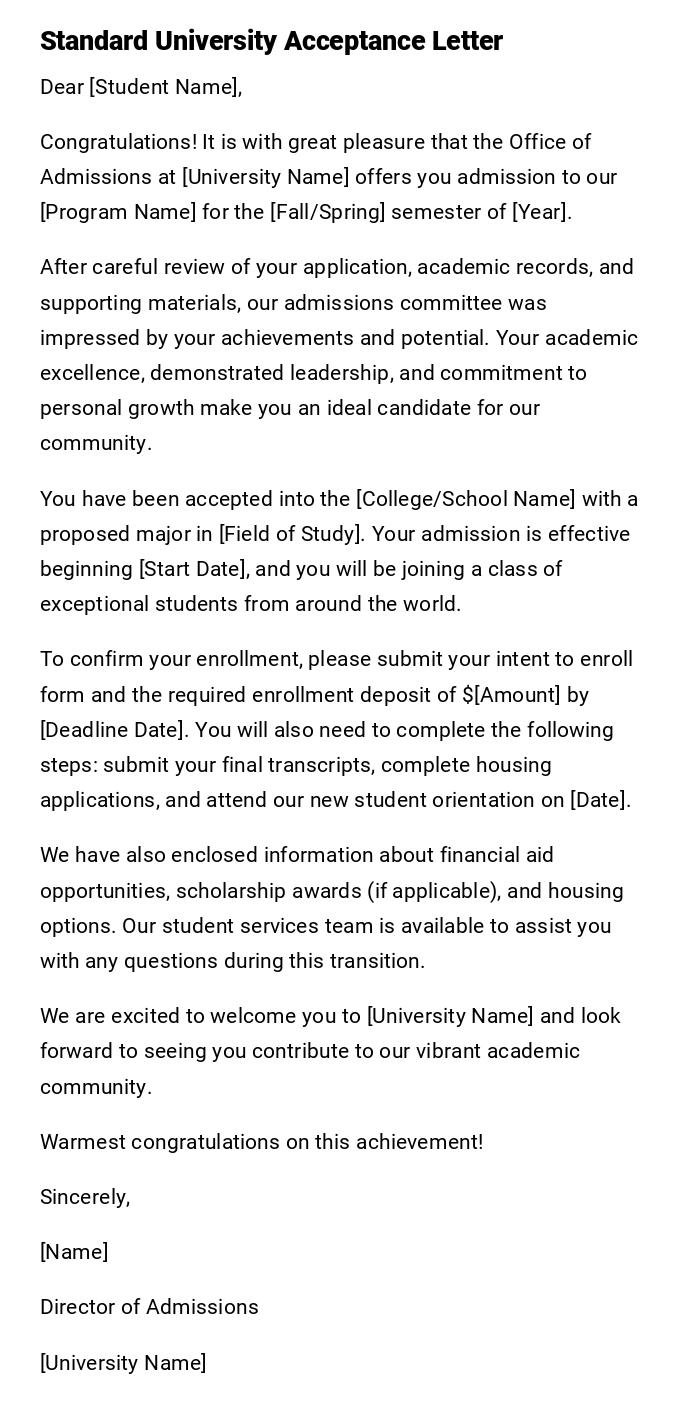
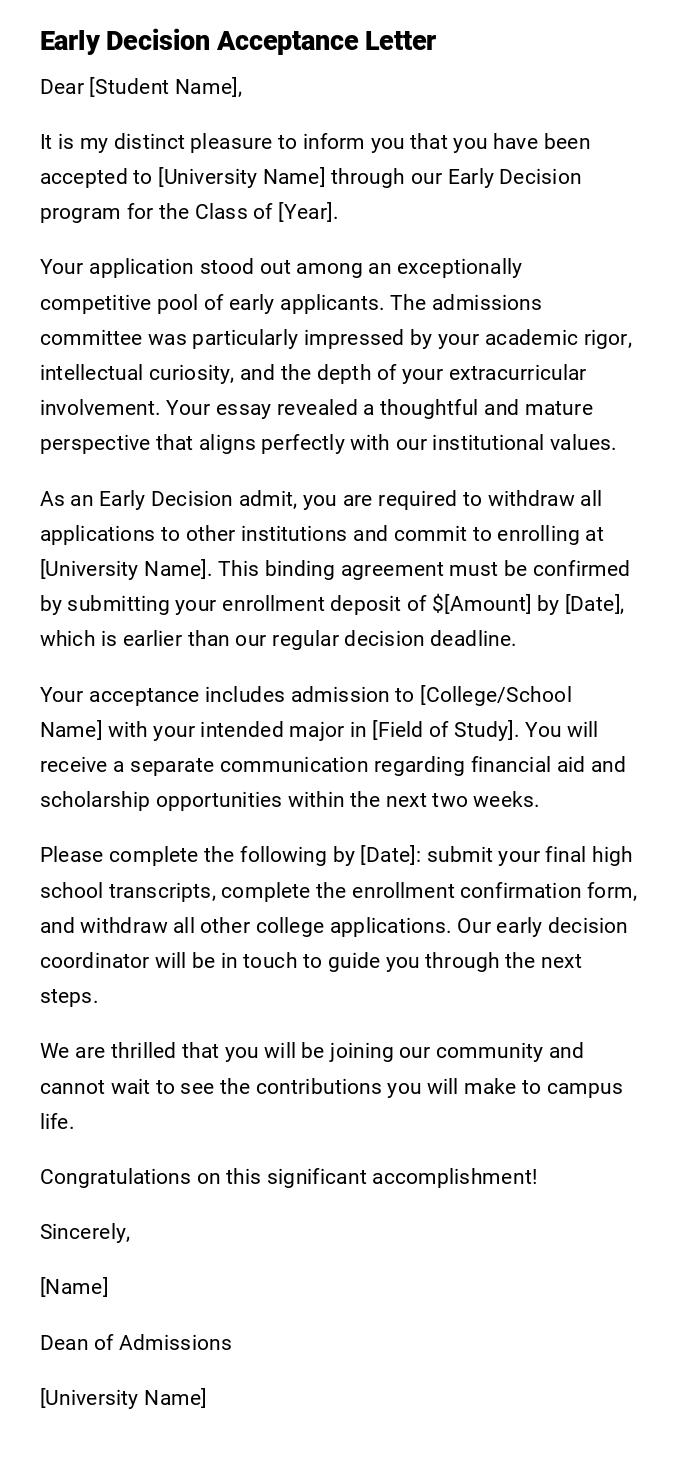
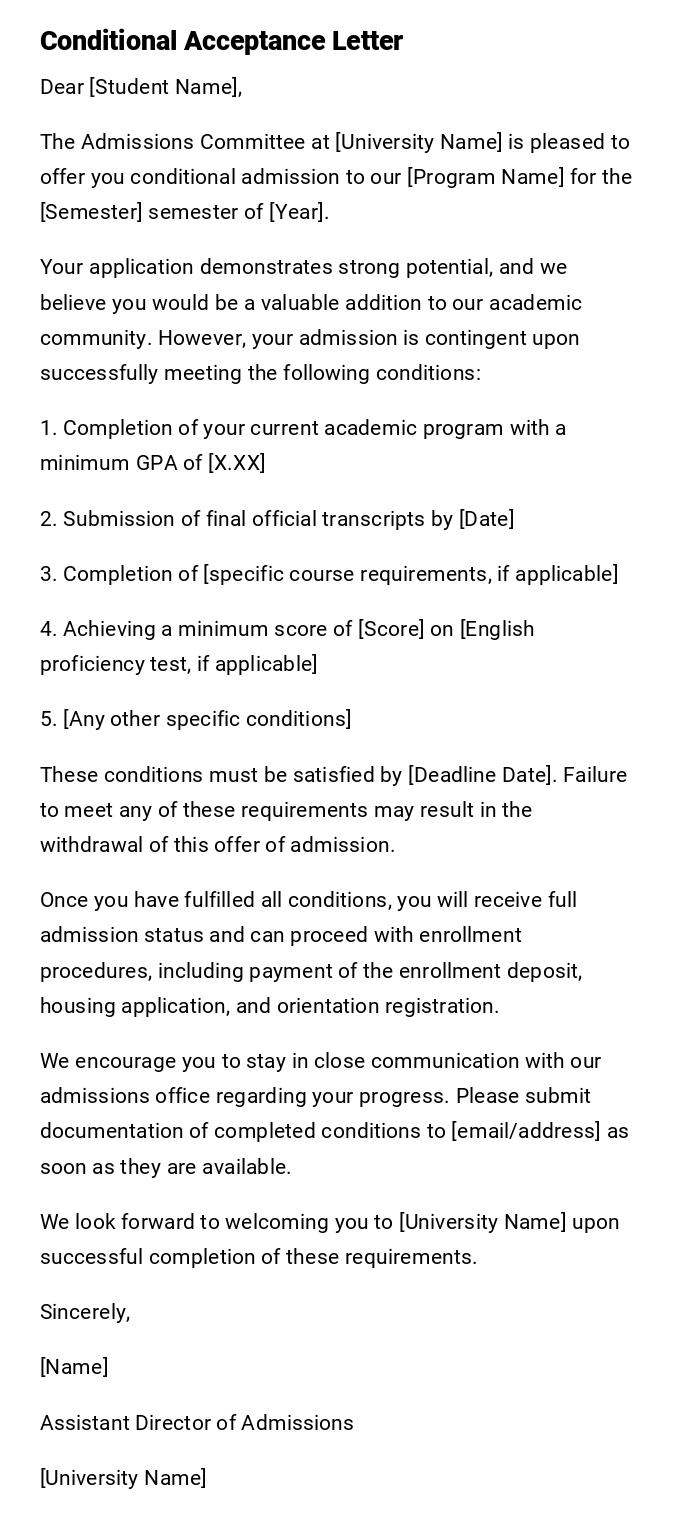
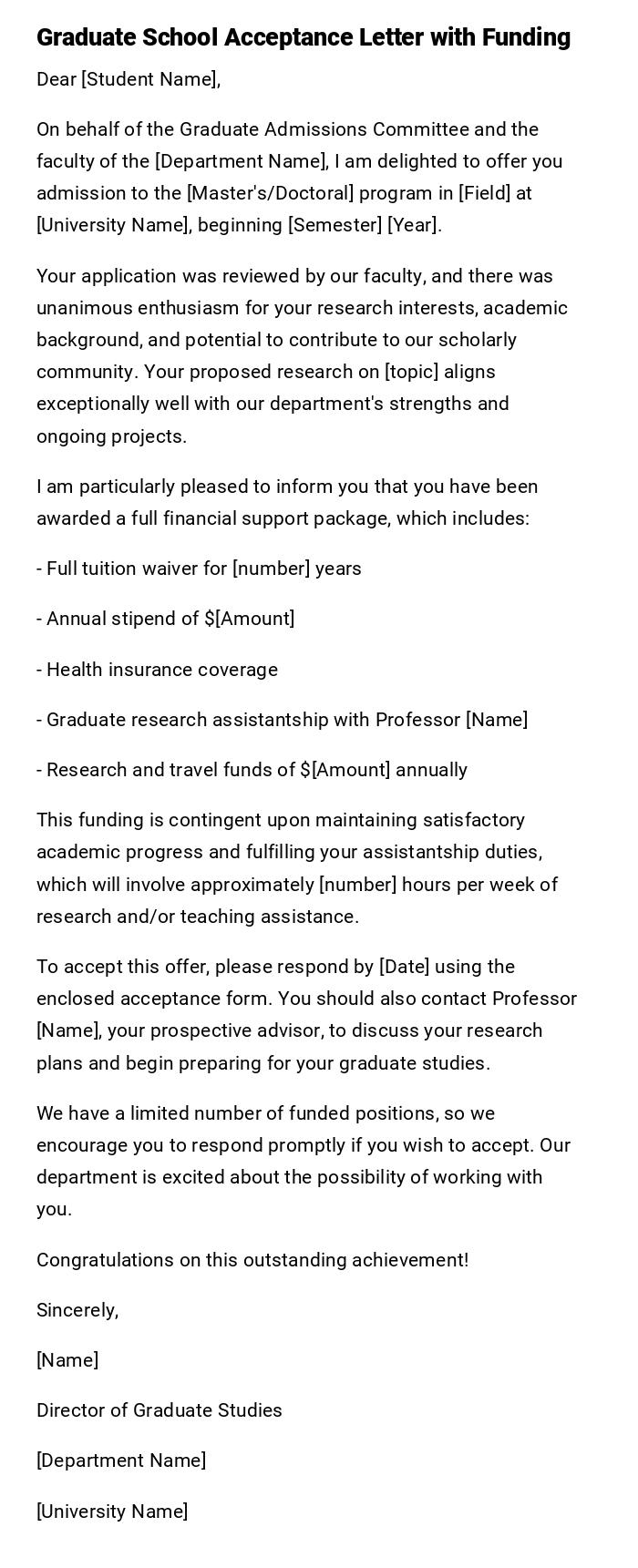
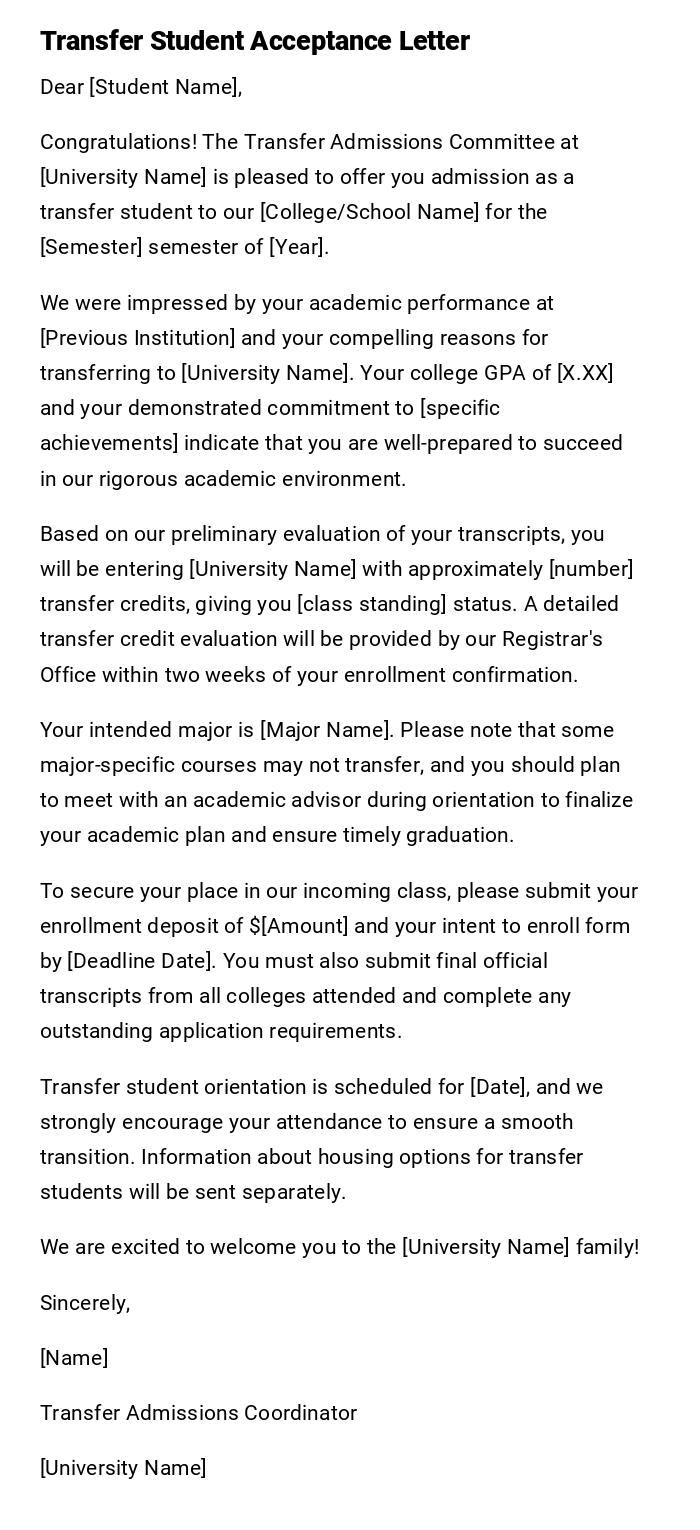
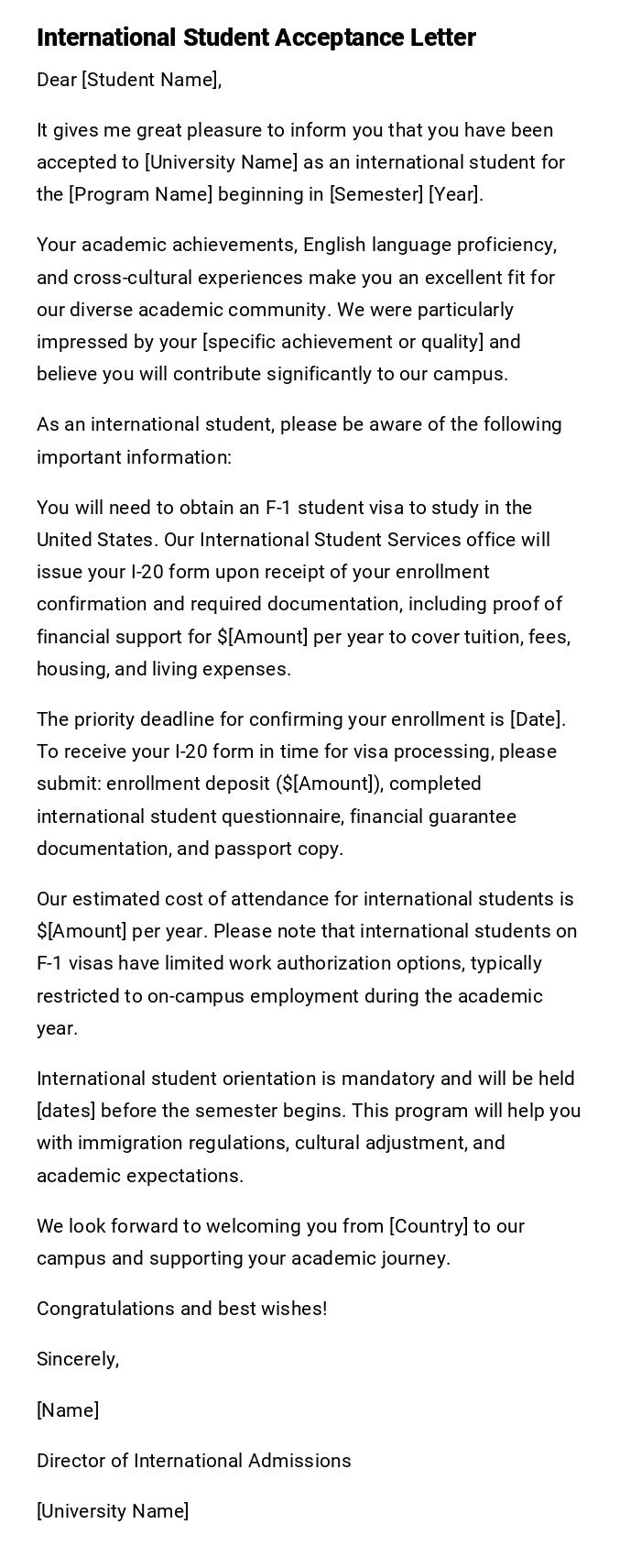
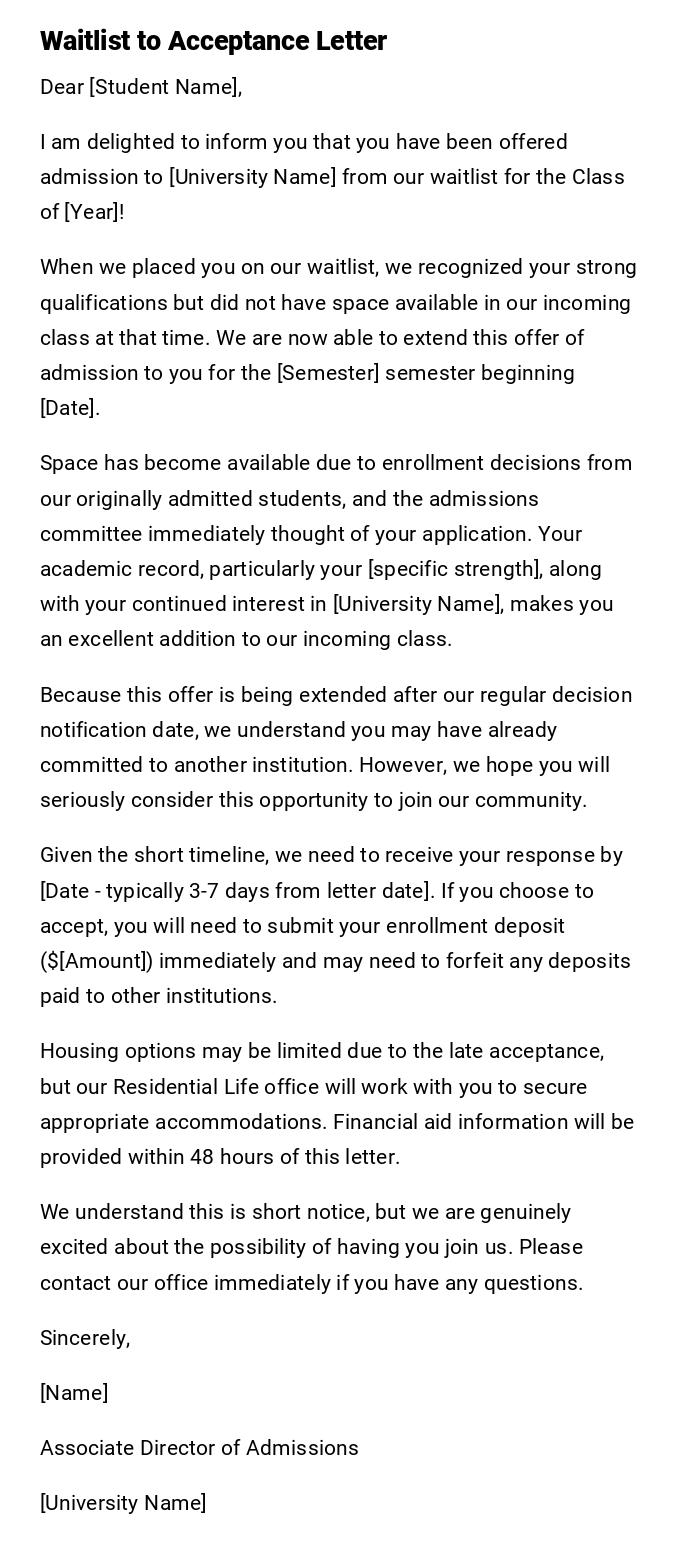
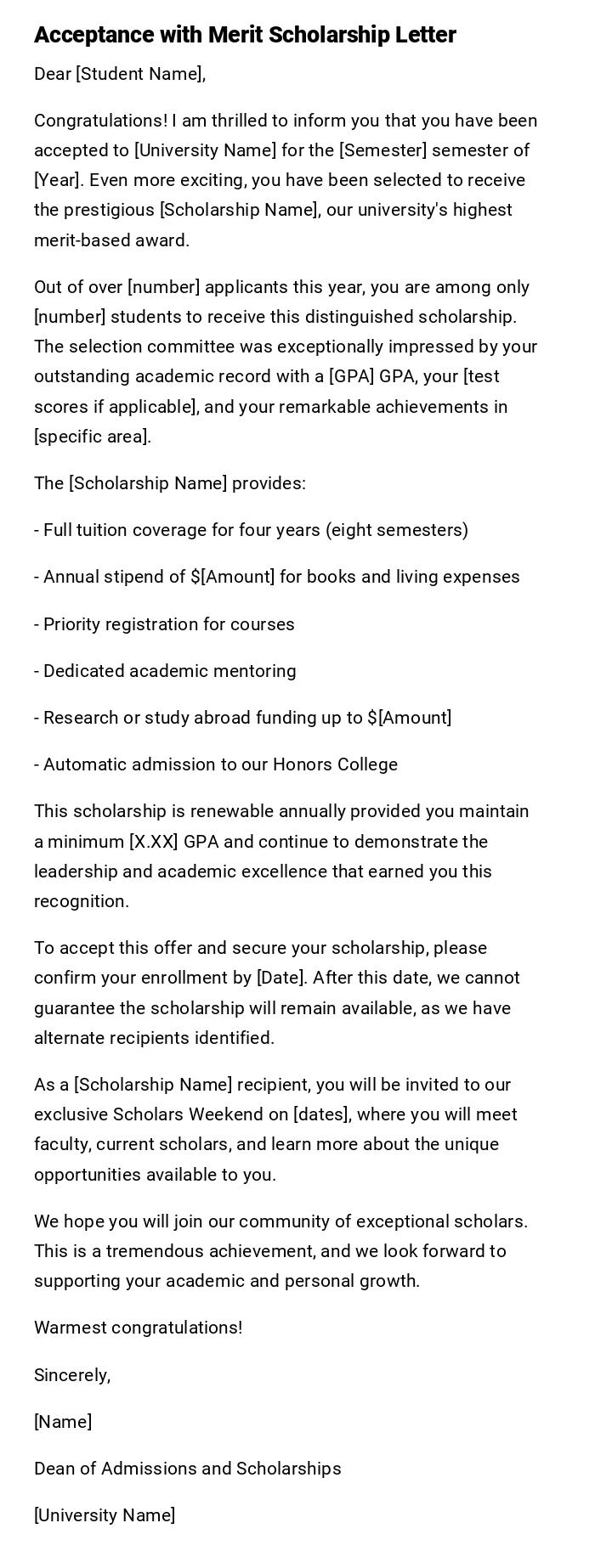

 Download Word Doc
Download Word Doc
 Download PDF
Download PDF